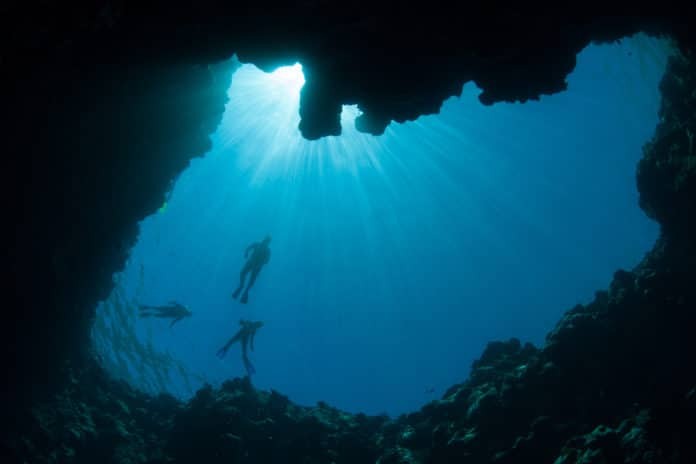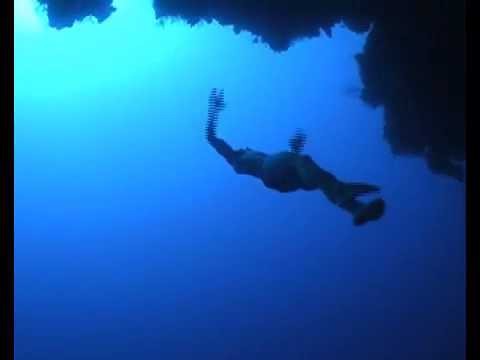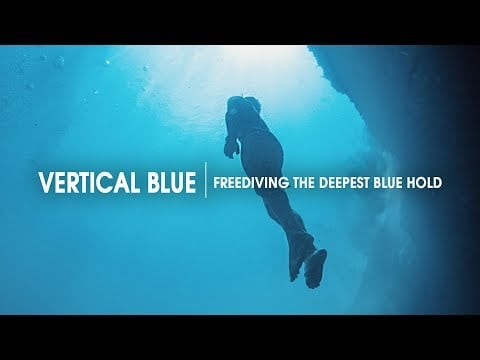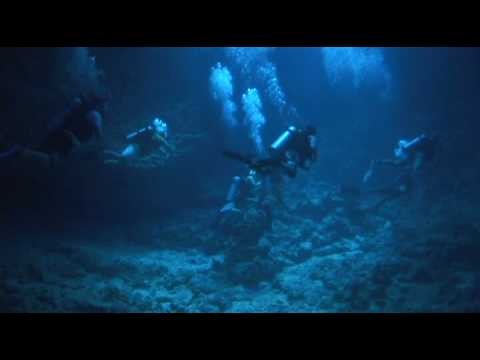As you approach the dive site, you can easily see where it is from the distance. It is not because of a buoy or unusually shaped nearby rock landscape, it is the water. The color of the water stands out, a deep blue. You are about to dive a Blue Hole. Blue Holes, even the name sounds inviting. They get their name from the intense deep blue color that stands out against the lighter blue or green surroundings. They provide a different environment than the surrounding seas and a unique dive experience.
A blue hole is a sinkhole whose opening is below the water level. In many ways, they are very similar to sinkholes found on land and have much in common with the cenotes of Mexico. The sinkholes were created by erosion and the karst processes, which is the chemical dissolution of carbonate rocks. At the time, the sea level was lower than it is today and the openings of the sinkholes were on land. Some Blue Holes are known to have been developed over different periods. Studies of the Belize Blue Hole show the development started more than 153,000 years ago. It became submerged when sea level rose, however, sea levels dropped exposing the sinkhole 66,000 years ago, then again 60,000 years ago, and the most recent 15,000 years ago. The effects of these time frames can be seen in the Blue Hole.
While each site is different, they normally are deeper than recreational diving limits. Many are a part of a cave system and most have sections that would be classified as a cavern dive. Still, most Blue Holes are available to recreational divers depending on the dive profile selected. Blue holes are found in many locations around the world, here are a few to “wet” your appetite.
The Great Blue Hole of Belize
![Great Blue Hole Belize Photograph By U.S. Geological Survey (USGS) [Public domain]](https://static2.deeperblue.com/wp-content/uploads/2017/04/Great_Blue_Hole.jpg)
Jacques Cousteau introduced the Great Blue Hole to the public in 1971 on his television series. He dubbed it one of the top 10 diving sites on the planet. Cousteau was also the first scientist to study this natural phenomenon. The striking appearance of the Blue Hole from the air has increased the area’s popularity.
Divers of all skill levels can enjoy this site. The top of the Blue Hole is about 10 meters of water and there is a slope down to 15 meters. Novice divers and snorkels can fully enjoy this dive. Beyond the slope, the water drops off to the 124-meter depth. Divers keep close to the walls to help keep from getting disoriented. This site is best enjoyed by deep divers and technical divers. As you reach the 30-meter mark there is an overhang, a part of an old cave system.
A little deeper you will come across the entrance of the cave with 6-meter tall stalagmites and stalactites. These stalagmites and stalactites are evidence that at one time this cave was dry. There is also a 12-degree slant in some of them showing that an earthquake shifts a portion of the cave at some point in the past.
Nitrogen Narcosis has been a contributing factor in a number of accidents at this site, some fatal. The clear water and sandy bottom which reflects light back up towards the diver can also cause some divers to lost track of their depths. It is very important that divers select a dive profile that is within their skill and ability levels. Then stay within the profile.
The typical dive trip to the Great Blue Hole is a three to four-hour long boat ride from another cay or from the Belize mainland. Once at the site, a diver will make a single dive into the Blue Hole. After a surface interval and lunch, a second dive is made at a different dive site. There are a number of other outstanding dive sites within the Lighthouse Atoll.
Divers wishing to explore the different dive sites around the atoll may want to stay at one of the resorts at Long Cay one of the cays within the Lighthouse Atoll.
Dahab, Egypt
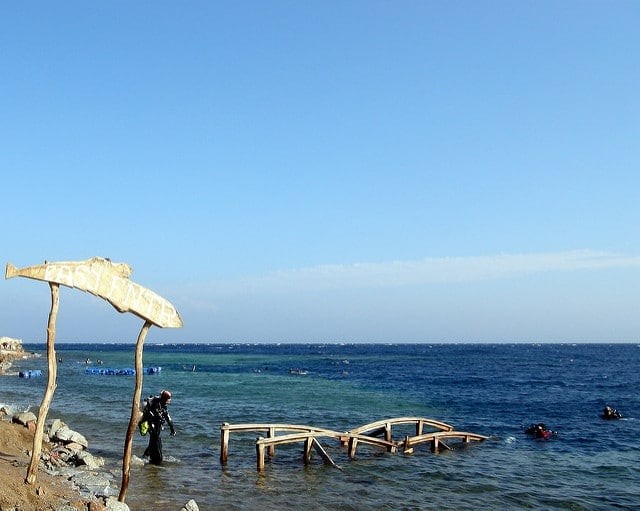
Just a few miles out into the desert along the coast near Dahab Egypt is a shore dive site marked with a sign that says “Easy Entry Blue Hole”. Sadly, the site has also been become known as the Diver’s Cemetery. Along the limestone rocks near the beach of this site are memorial markers for 14 divers who have lost their lives here. Locals say that is only about 10% of the divers who have died here over the last 15 years. Many of the bodies were not recovered and some may still wait at the 130 meter bottom of the site. You often see in articles, not written by divers, that say the biggest draw to this site is that it is so deadly.
The local experts agree that this is not an overly dangerous dive site. It is a popular attraction for tourist to come snorkeling and divers of all skill levels. It is about staying in your limits. Most of the deaths have been in pursuit of diving the arch. The arch is a large tunnel that connects the Blue Hole and the open sea.
The top of the arch is about 52 meters below the surface. The floor of the tunnel is about another 50 meters below. The light coming into the Blue Hole by way of the 28-meter long tunnel can cause divers to misjudge the depths. When divers enter the tunnel, the light in front of them makes the exit seem closer. There is also a current coming into the Blue Hole.
The top of the arch is deeper than the recreational dive limits for air. Still, divers do attempt the depth risking nitrogen narcosis and oxygen toxicity. Both of which can lead to death.
However, If you stay within the limits that are right for your training, skills, and equipment, the Blue Hole offers some excellent diving.
Dean’s Blue Hole, Bahamas
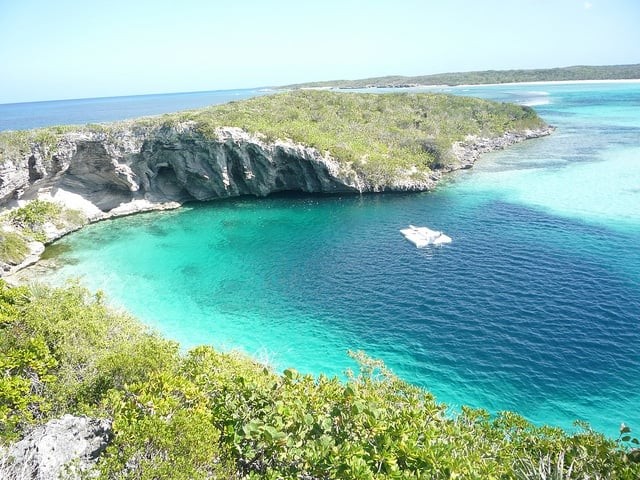
Dean’s Blue Hole is located on Long Island in the Bahamas. It is said to be the second deepest Blue Hole in the world with the recent discovery of a deeper one in the West Philippine Sea. The site reaches a depth of 663 feet. It is also said to be the largest underwater cavern in the world measuring 240 feet wide, 350 feet long and 603 feet high. While Long Island is isolated and outside of the normal tourist destination, the site is a popular destination for divers of all skill levels and freedivers. Snorkelers and novice divers will find the outstanding visibility and calm waters a delightful experience. Divers with more advanced skills can dive deeper and see the marine life that lives at different depths. This dive site is also a shore dive.
It’s also home to World Champion Freediver William Trubridge, his Freediving school and the annual “Wimbledon of Freediving” event Vertical Blue.
Blue Hole, Palau
The Blue Holes dive site in Palau is considered the second most popular dive site in Palau after Blue Corners. You will generally see this as plural as there are four holes in the reef that enter into the cavern. The shallow reef has entrances in just 3 to 6 feet of water (1 to 2 meters) with the depth of the cavern at about 120 feet (40 meters). Even novice divers doing a supervised cavern dive can enjoy this site. The cavern also has side exits, one at 45 feet (14 meters) and a larger one at 85 feet (27 meters). Currents can be strong if you exit the Blue Hole from one of the side exits. The most frequent dive here for experienced divers exits at the deeper window turn left for about 150 feet (45 meters) then join the current towards Blue Corners.
Blue Hole, Guam
Blue Hole Guam is the most popular boat dive site of the local divers. While close to the shore, the shoreline is made up of towering cliffs. The opening in the reef is around 60 feet (18 meters) and the hole drops down to about 300 feet (90 meters). Experience deep divers can shoot the hole at 125 feet (38 meters) coming out on the outer wall of the Blue Hole and follow the slope back towards the reef top. Visibility in the hole and surrounding areas are normally better than 100 feet (30 meters).
There are hundreds of blue hole sites around the world. Each with their own story, are you ready for the experience?

